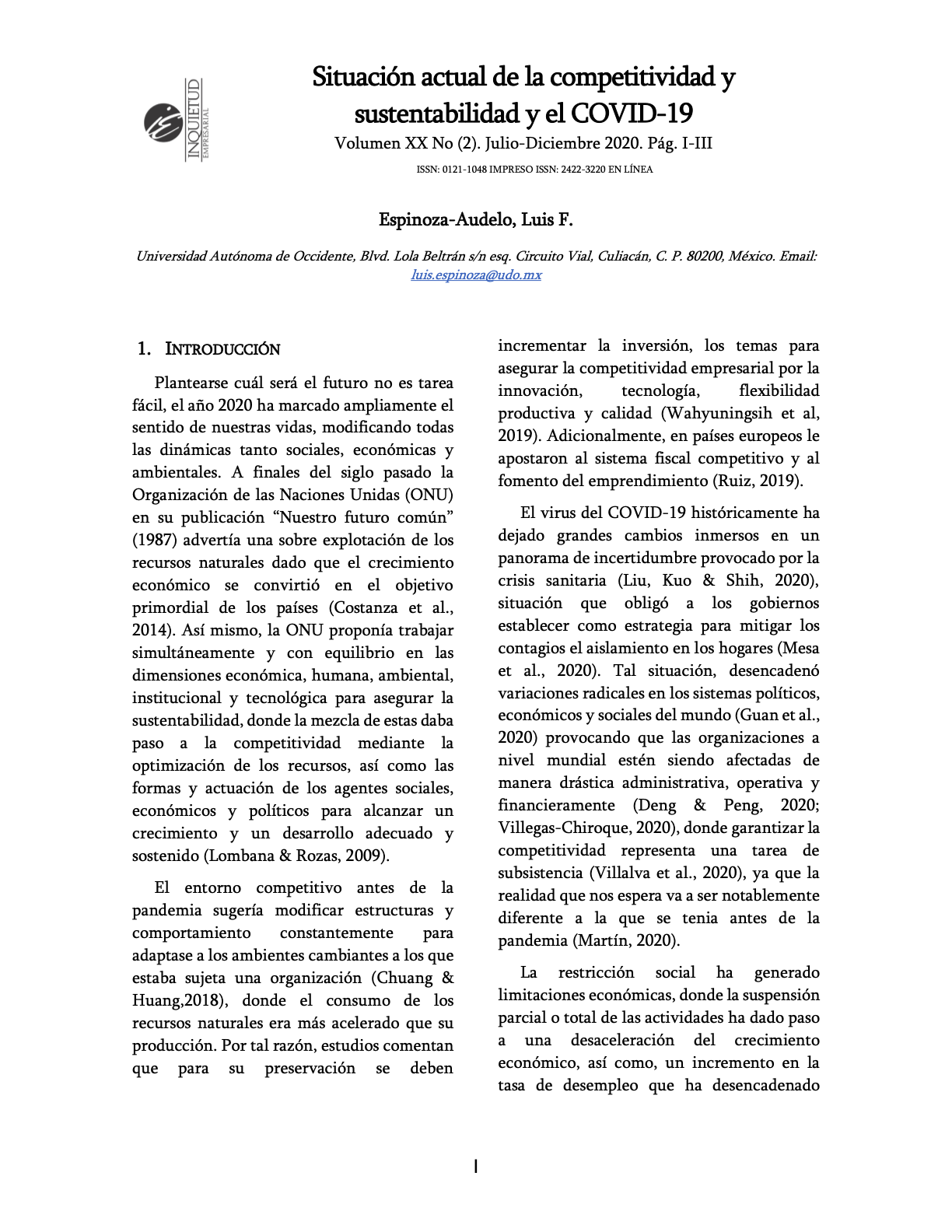Current situation of competitiveness and sustainability and COVID-19

Abstract
Thinking about what the future will be is not an easy task. The year 2020 has greatly marked the meaning of our lives, modifying all social, economic, and environmental dynamics. At the end of the last century, the United Nations (UN) in its publication "Our Common Future" (1987) warned of an over-exploitation of natural resources as economic growth became the primary objective of countries (Costanza et al., 2014). Likewise, the UN proposed working simultaneously and with the balance in the economic, human, environmental, institutional and technological dimensions to ensure sustainability, where the mixture of these gave way to competitiveness through the optimization of resources, as well as the forms and actions of social, economic and political agents to achieve adequate and sustained growth and development (Lombana & Rozas, 2009).
Received: 26/11/2020. Accepted: 28/11/2020. Published: 01/12/2020
Keywords
Competitiveness, sustainability
References
- CEPAL, N. (2020). Pactos políticos y sociales para la igualdad y el desarrollo sostenible en América Latina y el Caribe en la recuperación pos-COVID-19.
- CEPAL, N. (2020). Sectores y empresas frente al COVID-19: emergencia y reactivación.
- Chuang, S. P., & Huang, S. J. (2018). The effect of environmental corporate social responsibility on environmental performance and business competitiveness: The mediation of green information technology capital. Journal of Business Ethics, 150(4), 991-1009. DOI: https://doi.org/10.1007/s10551-016-3167-x
- Costanza, R., Cumberland, J. H., Daly, H., Goodland, R., Norgaard, R. B., Kubiszewski, I., & Franco, C. (2014). An introduction to ecological economics. CRC Press. DOI: https://doi.org/10.1201/b17829
- Deng, S. Q., & Peng, H. J. (2020). Characteristics of and public health responses to the coronavirus disease 2019 outbreak in China. Journal of clinical medicine, 9(2), 575. DOI: https://doi.org/10.3390/jcm9020575
- Foladori, G. (2007). Paradojas de la sustentabilidad: ecológica versus social. Trayectorias, 9(24), 20-30.
- Fryxell, G. E., & Enz, C. A. (2020). Value similarity about human resources, competitiveness and social responsibility: A study of organizational and suborganizational differences. The Social Studies: an International Journal, 6(1), 155-168.
- Fu, K. W., & Zhu, Y. (2020). Did the world overlook the media’s early warning of COVID-19?. Journal of Risk Research, 1-5. DOI: https://doi.org/10.1080/13669877.2020.1756380
- Gallen, S. (2020). The response of tourism businesses vis-à-vis the economic ramifications of SARS-CoV-2. Retrieved from. AIEST.
- GSS. (2004). Government statistical service. Recuperado el 23 de 11 de 2020, de https://www.gov.uk/search/all?keywords=Government+statistical+service+model+2004&order=relevance&page=8
- Guan, W. J., Ni, Z. Y., Hu, Y., Liang, W. H., Ou, C. Q., He, J. X., & Du, B. (2020). Clinical characteristics of coronavirus disease 2019 in China. New England journal of medicine, 382(18), 1708-1720. DOI: https://doi.org/10.1056/NEJMoa2002032
- Juárez‐Nájera, M., & Rivera, J. G. Martínez, and Wim A. Hafkamp. 2010." An Explorative Socio‐Psychological Model for Determining Sustainable Behavior: Pilot Study in German and Mexican Universities.". Journal of Cleaner Production, 18(7), 686-694. DOI: https://doi.org/10.1016/j.jclepro.2009.09.018
- Liu, Y. C., Kuo, R. L., & Shih, S. R. (2020). COVID-19: The first documented coronavirus pandemic in history. Biomedical journal. DOI: https://doi.org/10.1016/j.bj.2020.04.007
- Lombana, J., & Rozas Gutiérrez, S. (2009). Marco analítico de la competitividad: Fundamentos para el estudio de la competitividad regional. Pensamiento & gestión, (26), 1-38.
- Martín, R. L. (2020). Reflexiones Educativas para el posCovid-19. Recordando el Futuro. Revista Internacional de Educación para la Justicia Social, 9(3), 127-140. DOI: https://doi.org/10.15366/riejs2020.9.3.007
- Mesa, V. C., Franco, O. H., Gómez, R. C., & Abel, T. (2020). COVID-19: The forgotten priorities of the pandemic. Maturitas, 136, 38. DOI: https://doi.org/10.1016/j.maturitas.2020.04.004
- ONU, (1987). Nuestro futuro común. Madrid: Alianza.
- Ruiz, T. L. (2019). Libertad, igualdad, competitividad: En torno a la transfiguración de los valores europeos tras la era de la modernización. Tendencias Sociales. Revista de Sociología, (3), 131-157. DOI: https://doi.org/10.5944/ts.3.2019.23593
- Salcedo, M. P., Rebolloso, F., & Barber, C. (2010). El desarrollo sustentable. Modelo de conciliación entre el progreso económico, la justicia social y la preservación del medio ambiente. Gestión y estrategia, 37, 17-31. DOI: https://doi.org/10.24275/uam/azc/dcsh/gye/2010n37/Salcedo
- Santa María, R. M., Abando, J. C., & de la Mata, A. A. (2010). Un modelo causal de competitividad empresarial planteado desde la VBR: capacidades directivas, de innovación, marketing y calidad. Investigaciones Europeas de Dirección y Economía de la Empresa, 16(2), 165-188. DOI: https://doi.org/10.1016/S1135-2523(12)60117-8
- Villalva, M. F. G., Piza, I. A. C., Pataron, E. K. C., & Coello, C. R. M. (2020). La gestión administrativa y la competitividad de las microempresas durante y post la emergencia por Covid-19. Universidad y Sociedad, 12(S (1)), 100-105.
- Villegas-Chiroque, M. (2020). Pandemia de COVID-19: pelea o huye. Revista Experiencia en Medicina del Hospital Regional Lambayeque, 6(1). DOI: https://doi.org/10.37065/rem.v6i1.424
- Wahyuningsih, S. H., Sudiro, A., Troena, E. A., & Irawanto, D. (2019). Analysis of organizational culture with denison’s model approach for international business competitiveness. Problems and perspectives in management, (17, Iss. 1), 142-151. DOI: https://doi.org/10.21511/ppm.17(1).2019.13
- Weforum. (2019). Weforum. Recuperado el 22 de 11 de 2020, de http://www3.weforum.org/docs/WEF_TheGlobalCompetitivenessReport2019.pdf